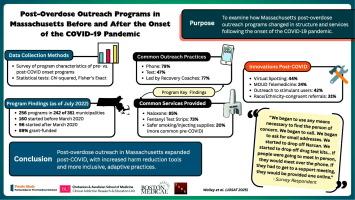Post-overdose outreach programs in Massachusetts before and after the onset of the COVID-19 pandemic
IF 1.9
0 PSYCHOLOGY, CLINICAL
Journal of substance use and addiction treatment
Pub Date : 2025-09-10
DOI:10.1016/j.josat.2025.209799
引用次数: 0
Abstract
Purpose
To describe the characteristics of Massachusetts post-overdose outreach programs before and after the onset of the COVID-19 pandemic and identify program adaptations and practices.
Methods
We surveyed Massachusetts post-overdose programs about programming onset, funding, outreach encounters, naloxone distribution, medication for opioid use disorder (MOUD) referrals, and program practices before and after the onset of the COVID-19 pandemic. We calculated frequencies and summary statistics for program characteristics and practices. We compared programs that started before and after the onset of the COVID-19 pandemic using Pearson Chi-squared and Fisher's Exact tests.
Results
As of July 2022, we identified 256 programs active in 242 (69 %) of Massachusetts' 351 municipalities. Before March 2020, 160 “pre-pandemic onset” programs were active. After March 2020, 96 “post-pandemic onset” programs started. In 2022, most were grant funded (89 % (227/256)). Initial survivor contact was attempted via phone (79 % (201/256)) and text (47 % (120/256)), most commonly by a recovery coach (77 % (196/256)). Most programs offered fentanyl test strips and naloxone. Some programs, more commonly pre-pandemic onset, offered safer smoking and injecting supplies. Among the 160 pre-pandemic onset programs, new practices included recommending virtual spotting (44 % (70/160)), facilitating MOUD telemedicine (24 % (39/160)), outreach for people using cocaine and methamphetamine (42 % (67/160)), and referring to race and ethnicity congruent services (31 % (50/160)).
Conclusion
Massachusetts post-overdose outreach programs expanded following the COVID-19 pandemic onset. Services and innovations included resources to reduce harms from the unregulated drug supply (e.g., fentanyl test strips) and more inclusive outreach (e.g., include people using stimulants and race and ethnicity congruent services).

在COVID-19大流行爆发前后,马萨诸塞州的过量用药后外展计划。
目的:描述马萨诸塞州在COVID-19大流行发生前后的过量用药后外展项目的特点,并确定项目的调整和实践。方法:我们调查了马萨诸塞州药物过量后项目的规划开始、资金、外展遭遇、纳洛酮分发、阿片类药物使用障碍(mod)转诊药物以及COVID-19大流行发生前后的项目实践。我们计算了频率和程序特征和实践的汇总统计。我们使用皮尔逊卡方检验和费雪精确检验比较了COVID-19大流行爆发前后开始的项目。结果:截至2022年7月,我们在马萨诸塞州351个城市的242个(69 %)中确定了256个项目。在2020年3月之前,160个“大流行前发病”项目处于活跃状态。2020年3月之后,96个“大流行后发病”项目启动。在2022年,大多数是拨款资助的(89% %(227/256))。通过电话(79 %(201/256))和短信(47 %(120/256))尝试与幸存者进行初步联系,最常见的是由恢复教练(77 %(196/256))联系。大多数项目提供芬太尼试纸和纳洛酮。一些项目,更常见的是在大流行爆发前,提供更安全的吸烟和注射用品。在160个大流行开始前的方案中,新的做法包括建议虚拟发现(44% %(70/160))、促进mod远程医疗(24% %(39/160))、向使用可卡因和甲基苯丙胺的人提供外展服务(42% %(67/160))以及参照符合种族和族裔的服务(31% %(50/160))。结论:马萨诸塞州在COVID-19大流行爆发后扩大了用药过量后的外展计划。服务和创新包括用于减少不受管制的药物供应(例如芬太尼试纸条)的危害的资源和更具包容性的外展(例如,包括使用兴奋剂的人以及符合种族和族裔的服务)。
本文章由计算机程序翻译,如有差异,请以英文原文为准。
求助全文
约1分钟内获得全文
求助全文
来源期刊

Journal of substance use and addiction treatment
Biological Psychiatry, Neuroscience (General), Psychiatry and Mental Health, Psychology (General)
自引率
0.00%
发文量
0
 求助内容:
求助内容: 应助结果提醒方式:
应助结果提醒方式:


